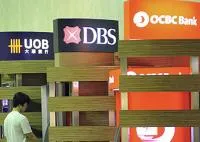
How home sale losses are crippling Singapore banks' profitability
Housing NPL ratio could be at risk.
In Singapore, cases of expensive homes sold at significant losses have stoked fears of more to come, potentially crimping banks’ profitability.
According to a research note from Maybank Kim Eng, however, history has showed that even during 1998-2003 when Singapore and ASEAN were buffeted by major economic setbacks, housing NPL ratios stayed below 5%.
Hard lessons learned, the impact should be more manageable in another major crisis, said the report.
At a 9.8% housing NPL ratio (currently 0.5%), extrapolated from OCBC’s peak during the Asian financial crisis, UOB should be the most vulnerable, with a 17.8% EPS risk. OCBC is next, with 14.0% and DBS, with 13.9%.
Here's more from Maybank Kim Eng:
History a good gauge. We think history is a good guide as Singapore is a homogeneous society and no major behavioural shifts among its home buyers have been detected so far.
Borrowers usually only default on their home loans as a last resort. The only difference today is banks’ greater exposure to the housing market, as HDB has scaled back its presence.
HDB’s current focus on lower-income households has reduced the banking system’s exposure to the financially less well-off.
While it has ceded substantial ground to banks over the past 10 years, it remains a key financier in the housing sector and continues to extend home financing to less well-off households.
Based on Mar 2014 data, housing loans extended by the HDB amounted to SGD36.6b, constituting 17.6% of all outstanding housing loans.
Housing loans’ historical resilience. Through the global slowdown in 2001, terrorist attacks in the US in Sep 2001 and SARS outbreak in 2002-03, Singapore banks’ housing NPL ratios stayed below 5%.
The exception was OCBC. The above rough economic patches served as hard lessons for the banks and regulators. Since then, banks have spruced up their risk-management systems.
OCBC, which suffered the most from the housing slippage during the Asian financial crisis, was far more insulated when GFC struck. Its housing NPLs continued to improve amid the global turbulence, defying industry trends.




![Lorem Ipsum [ABF 1]](https://cmg-qa.s3.ap-southeast-1.amazonaws.com/s3fs-public/styles/exclusive_featured_article/public/2025-03/a_hand_pointing_to_a_futuristic_technology_5b87c9d0e3_1.png.webp?itok=2w0y1WhS)


![Cross Domain [Manu + SBR + ABF + ABR + FMCG + HBR + ]](https://cmg-qa.s3.ap-southeast-1.amazonaws.com/s3fs-public/styles/exclusive_featured_article/public/2025-01/earth-3537401_1920_4.jpg.webp?itok=WaRpTJwE)







 Advertise
Advertise

